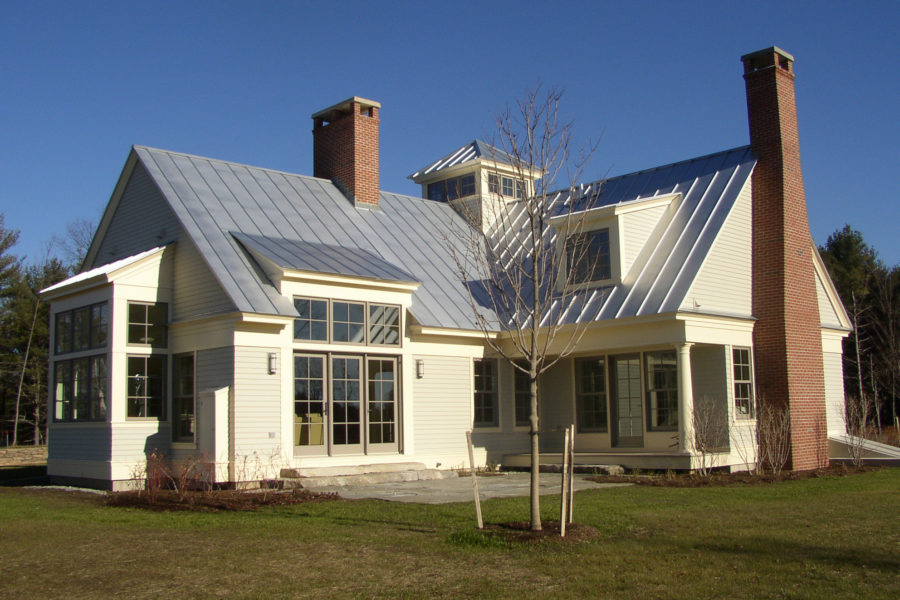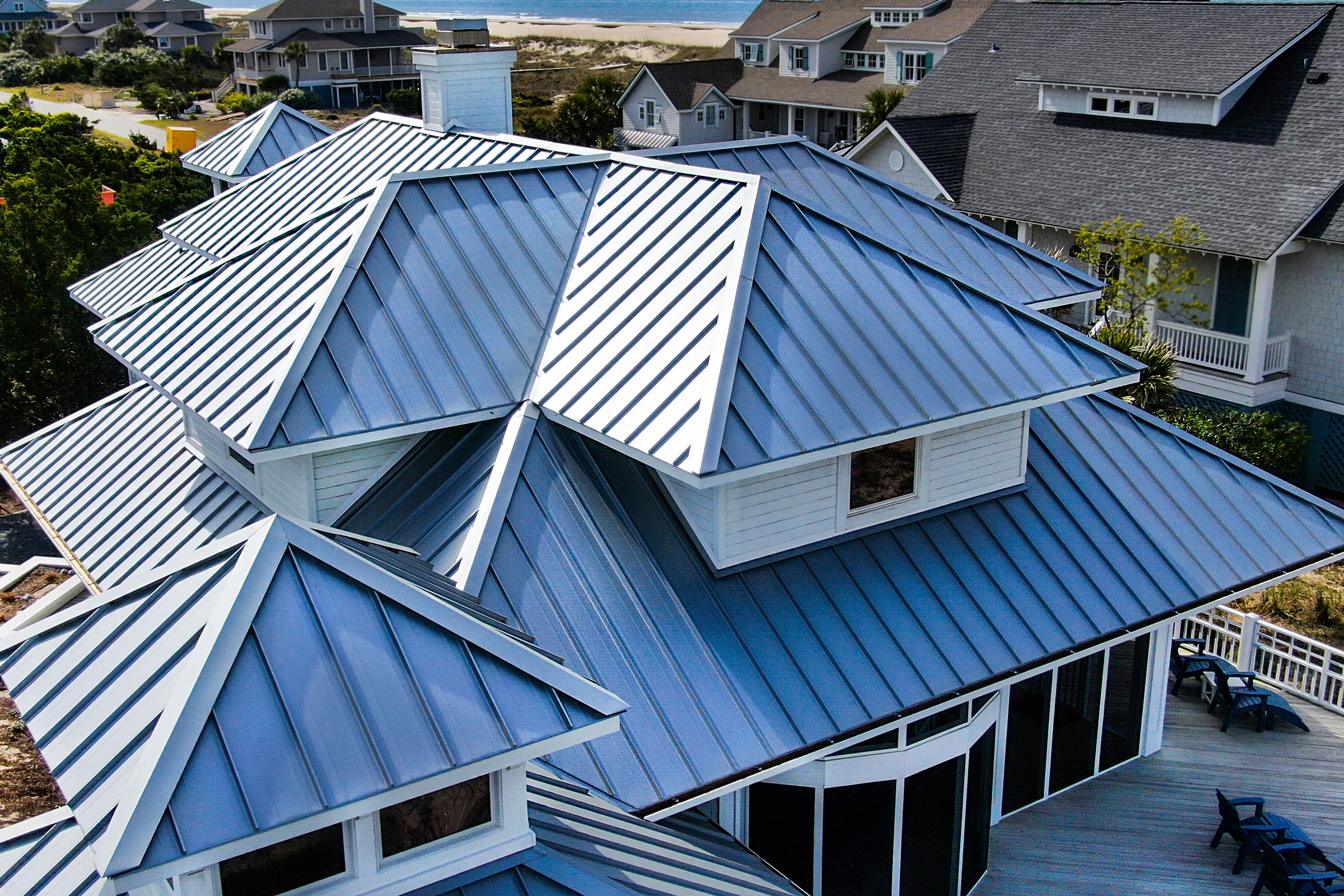The US EPA says, “Green building is the practice of creating structures and using processes that are environmentally responsible and resource-efficient throughout a building’s life cycle—from siting to design, construction, operation, maintenance, renovation, and deconstruction.” Metal roofing can play a significant role in environmentally friendly construction methods, including cool coatings and compliance with the LEED program.
Cool roofs reflect heat well across the entire solar spectrum—especially in the infrared and visible wavelengths. The less solar radiation materials absorb, the cooler they are. In addition to absorbing less heat, the coolest roofing materials radiate away any absorbed heat.
Urban areas produce what is called the urban heat island effect with dark, heat-absorbing roofs being among the chief culprits. The temperatures in the air above heat islands and their heat-absorbing roofs can be as much as 12 degrees Fahrenheit hotter than the surrounding suburbs. This leads to higher air conditioning costs, greater use of electricity, and unhealthy levels of smog and ozone.
Meanwhile, regulators across the country, seeking to lower peak energy consumption and reduce the heat island effect caused by dark urban surfaces, are writing specifications into construction contract documents that call for reflective roof surfaces. This new generation of metal oxide pigments—notably PPG’s ULTRA-Cool® line—allows darker colored roofs to reflect like lighter ones. This gives metal an edge over other materials in a market where dark colors are usually preferred. Add to this the material’s longevity and recyclability, and metal is well positioned to become the greenest cool roofing material of choice.
LEED and Metal Roofing

Photo courtesy of Englert
LEED Version 4.1 requires that roofing materials used on low slope roofs with a slope less than 2:12 must meet a solar reflectance index or SRI of 82. Steep-sloped roofs with a slope greater than or equal to 2:12 must have an SRI of 39.
The LEED program uses a credit or point system to establish overall building performance. Rating points are given for various sustainable features in five categories—building site, water efficiency, energy and atmosphere, materials and resources, and indoor environmental quality.
Ratings, categorized as Platinum, Gold, Silver, or Certified, are based on the number of points earned. A building rated Platinum needs at least 52 points out of a total of 57 to qualify, while a Gold rating means it has scored between 39 and 51 points. Between 33 and 38 points are needed to achieve the Silver level, while a Certified rating requires between 26 and 32 points.
A Platinum building would be able to effectively reduce its environmental impact by more than 7%, while a Gold building by an estimated 5%. Used as a guide toward environmental design, LEED standards were the collaborative brainchild of USGBC members. These include government, architects, interior designers, builders, manufacturer, and several branches of the military who conceived, tested, and voted on the rating criteria.
What is Solar Reflectance Index (SRI)?
According to USGBC’s requirements, an SRI is defined as “a measure of the constructed surface’s ability to reflect solar heat as shown by a small temperature rise. It is defined so that a standard black with reflectance of 0.05 and emittance of 0.90 is zero, while the SRI for a standard white with reflectance of 0.80 and emittance of 0.90 is 100.”
To calculate the SRI for a given material, it is necessary to obtain the reflectance and emittance values for the material. SRI is calculated according to ASTM E 1980, a standard practice for calculating the solar reflectance index of horizontal and low-sloped opaque surfaces with emissivity greater than 0.1. Reflectance is calculated according to any one of three ASTM standards—ASTM E903, ASTM E1918 or ASTM C1549.
Properties of Cool Roofs
The solar reflectance of cool roofs tends to decrease over time. This is because surface particles like dirt, dust, and air pollutants accumulate. Another factor that affects long-term solar reflectance is slope; the greater the angle of roof slope, the more dirt and particles dislodge and fall off the roof surface. Studies at the Florida State Energy Center show that during the first two years of a cool roof’s life span, solar reflectance can deteriorate up to 11% for a membrane roof if regular maintenance is not provided. However, studies by various Kynar paint manufacturers show that the solar reflectance of metal roofing material remains almost constant.
Regardless of their material, cool roof materials have two important surface properties: a high solar reflectance and a high thermal emittance. Solar reflectance is a measure of the ability of a surface material to reflect sunlight. This includes the visible, infrared, and ultraviolet wavelengths, on a scale from 0 to 1. Essentially it is the percentage of solar energy that is reflected by a surface. Solar reflectance is also called “albedo.”
Thermal emittance is defined as the percentage of energy a material can radiate away after it is absorbed. Solar emittance of a material refers to its ability to release absorbed heat. Scientists use a number between 0 and 1, or 0 to 100%, to express emittance. Except for metals, concrete, and masonry, most construction materials have emittances above 0.85 or 85%. While uncoated metal has an undesirable, low emittance, ULTRA-Cool coatings actually increase emittance values to greater than 85%. Uncoated steel has an emissivity of 10%, which means the material would hold heat absorbed during the day well into the night, causing air conditioning to run longer.
As previously mentioned, cool roofs reflect heat well across the entire solar spectrum, especially in the infrared and visible wavelengths. And the less solar radiation materials absorb, the cooler they are. The coolest roofing materials also radiate away any absorbed heat.
Solar reflectance and thermal emittance have noticeable effects on temperature. Conventional roof surfaces have low reflectance from 0.05 to 0.25 and high thermal emittance typically over 80%. These surfaces can heat up to 150 to 190°F at midday during the summer. Bare metal or metallic surfaced roofs have a high solar reflectance of 0.5 or higher and may have low thermal emittance anywhere between 20 to 60%, depending on their surface treatment. These surfaces warm to 140 to 170°F. Cool roofs with both high reflectance and high emittance warm to only 100 to 120°F in the summer sun.
The architectural community has embraced the concept of sustainability using the LEED program as an economic and environmental standard for measuring construction products and systems conducive to green building. Tens of thousands of building and design professionals have earned LEED certification, which uses known standards and other qualification programs to provide the necessary data for qualification.
In conclusion, metal roofing is an important component in addressing concerns over building approaches that are harmful to the environment. Through LEED methods and modern construction practices the structures we build can have significantly less adverse impact on our planet.


